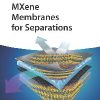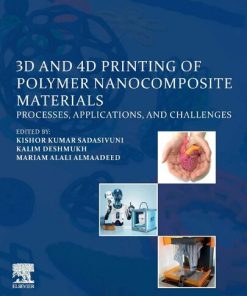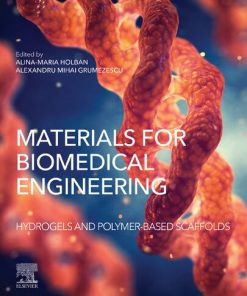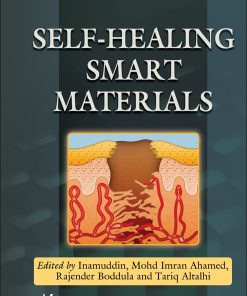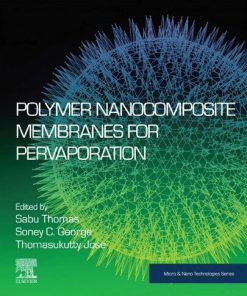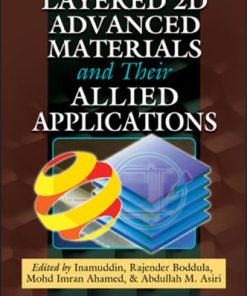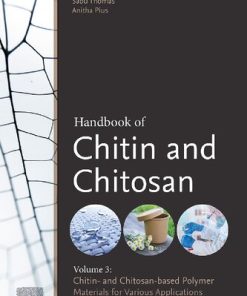(Ebook PDF) Polymer Nanocomposite Based Smart Materials From Synthesis to Application 1st edition by Rachid Bouhfid, Abou el Kacem Qaiss, Mohammad Jawaid 0081030142 9780081030141 full chapters
$50.00 Original price was: $50.00.$25.00Current price is: $25.00.
Polymer Nanocomposite-Based Smart Materials: From Synthesis to Application 1st edition by Rachid Bouhfid, Abou el Kacem Qaiss, Mohammad Jawaid – Ebook PDF Instant Download/DeliveryISBN: 0081030142, 9780081030141
Full download Polymer Nanocomposite-Based Smart Materials: From Synthesis to Application 1st edition after payment
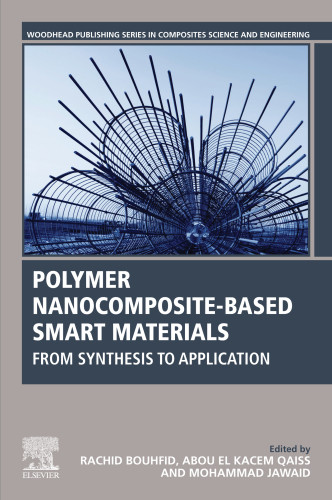
Product details:
ISBN-10 : 0081030142
ISBN-13 : 9780081030141
Author: Rachid Bouhfid, Abou el Kacem Qaiss, Mohammad Jawaid
Polymer Nanocomposite-Based Smart Materials: From Synthesis to Application provides a broad, comprehensive review on all major categories of smart materials and their preparation routes. The main application fields and properties for these diverse types of smart polymer-based composite and nanocomposite materials are also discussed. Chapters on modeling methods and simulation look at the physical or chemical change response that is introduced by the effect of changing environmental conditions such as pH, temperature, mechanical force and light. Written by scholars and experts from around the globe, the book covers key aspects, such as synthesis, processing and applications of polymer and nanocomposite-based smart materials.
Polymer Nanocomposite-Based Smart Materials: From Synthesis to Application 1st Table of contents:
1 – Introduction: different types of smart materials and their practical applications
1 Introduction to smart materials
2 Smart materials: definition and fundamental characteristics
3 Types of smart materials
3.1 Piezoelectric materials
3.2 Magnetostrictive materials
3.3 Shape-memory alloys
3.4 Chromic materials
3.5 Thermoresponsive materials
4 Application of smart materials
5 Conclusion
References
2 – Role of characterization techniques in evaluating the material properties of nanoparticle-based
1 Introduction
2 Crystallographic properties
3 Morphological properties
4 Thermal properties
5 Antimicrobial properties
6 Conclusion
References
3 – Self-healing based on composites and nanocomposites materials: from synthesis to application and
1 – Introduction
1.1 Types of healing process in polymers
1.1.1 – Intrinsic self-healing polymers
1.1.2 – Extrinsic self-healing polymers
1.1.2.1 – Vascular self-healing materials
1.1.2.2 – Microcapsules-based self-healing materials
1.2 – Practical applications of self-healing polymers
1.2.1 – Self-healing coating systems
1.2.2 – Healing in presence of structural reinforcements
1.3 – Evaluation of healing efficiency
1.3.1 – Quasi-static fracture
1.3.2 – Fatigue
1.3.3 – Impact damage/indentation
1.4 – Theoretical models of healing mechanisms
2 – Conclusion
References
4 – Thermochromic composite materials: synthesis, properties and applications
1 Introduction
2 Thermochromic materials classification
2.1 Inorganic reversible thermochromic materials
2.1.1 Crystal water gain/loss mechanism
2.1.2 Crystal transfer mechanism
2.2 Liquid crystal
2.3 Organic reversible thermochromic materials
2.3.1 Structural change in the molecule
2.3.1.1 Crystal transition mechanism
2.3.1.2 Dimensional structure change
2.3.1.3 Intermolecular proton transfer
2.4.1 Intermolecular electron transfer
3 Thermochromic material synthesis
3.1 Liquid phase deposition
3.2 Solid phase deposition
3.3 Vapor deposition
4 Properties of thermochromic composite materials
5 Thermochromic material applications
5.1 Textile field
5.2 Thermochromic smart window
5.3 Anticounterfeiting field
5.4 Sensors
5.5 Temperature indicators
6 Conclusion
References
5 – Piezoelectric polymer films: synthesis, applications, and modeling
1 Introduction
2 Piezoelectric polymers: types, fabrication, and applications
2.1 Bulk polymers
2.2 Piezocomposites
2.3 Charged cellular polymer films (ferroelectrets)
2.3.1 Most used cellular polymers
2.3.2 Case study: development of cellular polyethylene ferroelectrets
3 Modeling of the piezoelectric coefficient d33
3.1 Modeling of the elastic stiffness (c33)
4 Conclusion and future directions
References
6 – Shape memory based on composites and nanocomposites materials: from synthesis to application
1 Introduction
2 Shape-memory materials
3 Shape-memory polymers
3.1 Background and definition
3.2 Classification of shape-memory polymers
3.3 Comparison between thermoplastic and thermoset SMPs
3.4 Architecture of shape-memory polymers
3.5 Stimulus methods of shape-memory polymers
Shape-memory polymers composites
4.1 Why use SMPCs instead of SMPs?
4.2 Reinforced shape-memory polymers composites (SMPCs)
4.2.1 Particle-filled shape-memory polymer composites
4.2.2 Fiber-reinforced shape-memory polymers
4.3 Shape-memory effects in polymer composites
4.4 Applications of SMPs and their composites
4.4.1 Biomedical applications
4.4.2 Other applications (deployable structures and actuators)
5 Conclusion
References
7 – Self-assembling smart materials for biomaterials applications
1 Introduction
2 Self-assembly of materials
2.1 The importance of self-assembly
2.2 Nanoscale building blocks for self-assemble smart biomaterials
2.2.1 Inorganic and organic nanostructures in smart biomaterials
2.3 Self-assembly of materials and biomolecules under internal interaction
2.4 Self-assembly of materials and biomolecules under external stimuli
2.4.1 pH-responsive self-assembly
2.4.2 Temperature-responsive self-assembly
2.4.3 Ionic strength-responsive self-assembly
2.4.4 Photo-responsive self-assembly
3 Self-assemble polymeric nanostructures in smart biomaterials
3.1 Micelles
3.2 Hybrid hydrogels
3.2.1 Polymeric hydrogels
3.2.2 Self-assembling DNA hydrogels
3.2.3 Hybrid hydrogels-based DNA self-assembly
3.2.4 Self-assembling poly polypeptide-based hydrogels
3.3 Dendrimers
3.3.1 Polypeptide dendrimers
3.3.2 Polyester dendrimers
3.3.3 Polyacetal dendrimers
4 Biomolecules as self-assemble smart biomaterials
4.1 Self-assemble DNA as a smart biomaterial
4.2 Self-assemble protein as a smart biomaterial
4.3 Self-assemble peptides as a smart biomaterial
Conclusion and future directions
References
8 – Electroactive polymer composites and applications
1 Introduction
2 Mechanism
3 Applications of electroactive polymers
3.1 Used in aerospace applications
3.2 Used in biomedical applications
3.3 Used in space applications
3.4 Used in automotive applications
4 Conclusions
References
9 – Polymer nanocomposites smart materials for energy applications
1 Introduction
1.1 Application on polymer nanocomposites-based smart materials in energy generation
2 Application on polymer nanocomposites based smart materials for energy storage
3 Challenges in polymer nanocomposites for energy application
4 Conclusion
References
10 – Smart materials for medical applications
1 Introduction
2 Silk: an excellent smart material
3 Silk smart materials based on structures
3.1 3D structures
3.2 Particle structures
3.3 Film structures
4 Smart silk material in medical applications
4.1 Drug delivery applications
4.2 Tissue engineering
4.3 Sutures
4.4 Wound dressing
4.5 Dentistry
4.6 Electronic applications
4.6.1 Biosensing devices
4.6.2 Optical devices
4.6.3 Switching memory devices
5 Conclusion and future directions
Acknowledgment
References
11 – Smart composite materials for civil engineering applications
1 Introduction
2 Applications of composite materials in civil engineering
2.1 Concrete
2.2 Road construction
2.3 Sensors
2.4 Repair and rehabilitation of historical monuments
3 Conclusion
Acknowledgment
References
12 – Molecularly imprinted polymer for water contaminants
1 Introduction
2 Adsorbent technology on water contaminants
3 The principle of molecularly imprinted polymer
3.1 Factors affecting the molecular imprinting process
3.1.1 Functional monomer
3.1.2 Cross-linking agents
3.1.3 Porogen
3.1.4 Initiator
3.1.5 Methods of preparation for molecularly imprinted polymer
4 Applications of MIP on water pollution
4.1 Heavy metals
4.2 Dyes
4.3 Polycyclic aromatic hydrocarbons (PAHs)
4.4 Micropollution
5 Conclusion
People also search for Polymer Nanocomposite-Based Smart Materials: From Synthesis to Application 1st:
polymer nanocomposite based smart materials
what is nanocomposite material
what are natural polymers made of
what material is polymer
what are the raw materials used to manufacture synthetic polymers
Tags:
Polymer Nanocomposite,Based Smart,Materials,Synthesis,Application,Rachid Bouhfid,Abou el Kacem Qaiss,Mohammad Jawaid
You may also like…
Engineering
Engineering - Bioengineering
Engineering - Industrial Engineering & Materials Science
Engineering
Engineering
Renewable Polymers and Polymer-Metal Oxide Composites: Synthesis, Properties, and Applications



